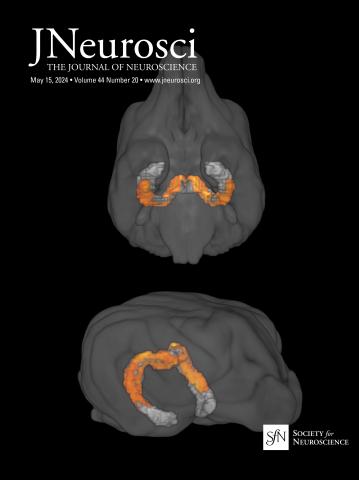Threonine-53 phosphorylation of dopamine transporter dictates kappa opioid receptor mediated locomotor suppression, aversion, and cocaine reward.
IF 4.4
2区 医学
Q1 NEUROSCIENCES
引用次数: 0
Abstract
Dynorphin (DYN)/kappa opioid receptor (KOR) activation contributes to aversion, dysphoria, sedation, depression, and enhanced psychostimulant-rewarding effects by inhibiting dopamine (DA) release. The precise neuronal mechanisms underlying these effects remain unclear, limiting the use of KOR agonists in treating mood and substance use disorders. DYN fibers form synapses with DA terminals that express KOR and dopamine transporter (DAT), which is crucial for regulating DA dynamics and related behaviors. Previously, we demonstrated that KOR agonists upregulate DAT activity via ERK1/2 signaling involving phospho-Thr53 DAT (pT53-DAT). However, it remains unclear whether pT53-DAT is involved in KOR-mediated DAT regulation in vivo and whether such a phenomenon contributes to the behavioral effects of KOR agonism. In this study, we utilized male DAT-Ala53 knock-in mice with non-phosphorylatable Ala at position 53 to investigate the role of pT53-DAT in KOR-mediated DAT regulation and its behavioral effects. KOR agonist U69593 increased KOR antagonist-sensitive DAT activity, DAT Vmax, pT53-DAT, and surface expression in WT but not in DAT-Ala53 mice. KOR agonists caused locomotor suppression, conditioned place aversion (CPA), and enhanced cocaine preference (CPP) in WT but not in DAT-Ala53 mice. Conversely, both WT and DAT-Ala53 mice exhibited similar lithium chloride-induced CPA and morphine-induced CPP. These findings provide the first causal evidence that KOR-mediated locomotor suppression, aversive response, and enhancement of cocaine reward manifest through the modulation of DAT activity via DAT-T53 phosphorylation. This suggests that targeting specific DAT-regulatory motif(s) may help develop new KOR-directed therapeutic strategies devoid of adverse effects.Significance Statement Preclinical and clinical research reveal that cocaine use disorder (CUD) affects mesolimbic dopamine neurotransmission, dopamine transporters (DAT), and DA interactions with the dynorphin (DYN)/kappa opioid receptor (KOR) system. The lack of FDA-approved treatments for CUD highlights a significant gap in our understanding of its neurobiology. While KOR ligands have potential as therapies, their effectiveness is often limited by side effects like aversion, dysphoria. and enhancing cocaine reward. Our study demonstrates that phosphorylation of Thr53 motif in DAT is crucial for KOR-mediated aversion, locomotor suppression, and enhancement of cocaine reward. These findings provide the first neurobiological evidence linking DAT-Thr53 phosphorylation to KOR modulation of DA clearance, highlighting its contribution to adverse behavioral outcomes and opening avenues for effective CUD treatments.多巴胺转运蛋白苏氨酸-53磷酸化决定了阿片受体介导的运动抑制、厌恶和可卡因奖励。
动啡(DYN)/kappa阿片受体(KOR)的激活通过抑制多巴胺(DA)的释放导致厌恶、烦躁、镇静、抑郁和增强的精神刺激奖励效应。这些作用背后的确切神经元机制尚不清楚,限制了KOR激动剂在治疗情绪和物质使用障碍中的应用。DYN纤维与DA末端形成突触,表达KOR和多巴胺转运蛋白(DAT),这对DA动力学和相关行为的调节至关重要。先前,我们证明了KOR激动剂通过涉及磷酸化thr53 DAT (pT53-DAT)的ERK1/2信号通路上调DAT活性。然而,目前尚不清楚pT53-DAT是否参与体内KOR介导的DAT调节,以及这种现象是否有助于KOR激动作用的行为效应。在本研究中,我们利用53位Ala不可磷酸化的雄性DAT- ala53敲入小鼠来研究pT53-DAT在kor介导的DAT调节中的作用及其行为效应。KOR激动剂U69593在WT中增加了KOR拮抗剂敏感的DAT活性、DAT Vmax、pT53-DAT和表面表达,但在DAT- ala53小鼠中没有增加。KOR激动剂在WT小鼠中引起运动抑制、条件性地方厌恶(CPA)和增强可卡因偏好(CPP),但在DAT-Ala53小鼠中没有。相反,WT和DAT-Ala53小鼠均表现出类似的氯化锂诱导的CPA和吗啡诱导的CPP。这些发现提供了第一个因果证据,证明kor介导的运动抑制、厌恶反应和可卡因奖励增强是通过DAT- t53磷酸化调节DAT活性来表现的。这表明,靶向特定的dat调控基序可能有助于开发新的无不良反应的针对kor的治疗策略。临床前和临床研究表明,可卡因使用障碍(CUD)影响中脑边缘多巴胺神经传递、多巴胺转运体(DAT)以及DA与运动啡肽(DYN)/kappa阿片受体(KOR)系统的相互作用。缺乏fda批准的治疗CUD的方法凸显了我们对其神经生物学的理解存在重大差距。虽然KOR配体有治疗的潜力,但它们的效果往往受到副作用的限制,如厌恶,烦躁不安。增强可卡因奖励。我们的研究表明,DAT中Thr53基序的磷酸化对于kor介导的厌恶、运动抑制和可卡因奖励的增强至关重要。这些发现首次提供了将DAT-Thr53磷酸化与DA清除的KOR调节联系起来的神经生物学证据,强调了其对不良行为结果的贡献,并为有效的CUD治疗开辟了途径。
本文章由计算机程序翻译,如有差异,请以英文原文为准。
求助全文
约1分钟内获得全文
求助全文
来源期刊

Journal of Neuroscience
医学-神经科学
CiteScore
9.30
自引率
3.80%
发文量
1164
审稿时长
12 months
期刊介绍:
JNeurosci (ISSN 0270-6474) is an official journal of the Society for Neuroscience. It is published weekly by the Society, fifty weeks a year, one volume a year. JNeurosci publishes papers on a broad range of topics of general interest to those working on the nervous system. Authors now have an Open Choice option for their published articles
 求助内容:
求助内容: 应助结果提醒方式:
应助结果提醒方式:


